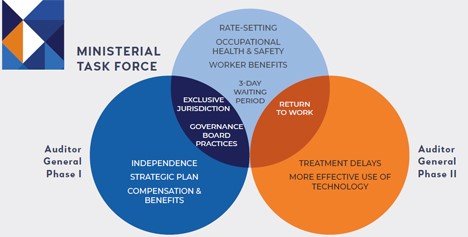



The results of these reviews will be integral in shaping the future of our organization and played a pivotal role in our 2019 priorities and results.
The first review was by a Task Force appointed in 2017 by the Minister of Post-Secondary Education Training and Labour (PETL) to examine New Brunswick’s workers’ compensation system, focusing on short term solutions and long-term sustainability. The findings, released in the summer of 2018, were designed to improve workplace health and safety, strike the right balance among compensation for injured workers, the employers’ financial interest and long-term sustainability of the system and addressed a number of areas, including rate-setting, benefits, rehabilitation, and improvements to the appeals process and return-to-work programs.
The other two reviews underway in 2018 were value-for-money audits by the Office of the Auditor General. The first audit (Phase I) focused on WorkSafeNB’s governance model with recommendations presented in June 2018, while the second audit (Phase II) looked at our claims management and rehabilitation system and recommendations were shared in January 2019.
WorkSafeNB welcomed all three of these reviews as we believe their findings will help us become an even better organization. Having the benefit of external experts carefully analyzing your business with a fresh set of eyes is always a learning experience for any organization. We accepted all the recommendations made by the Ministerial Task Force and the Auditor General and have implemented, or are in the process of implementing, all of them.
These reviews led to important legislative amendments enacted in December 2018, June 2019, and December 2019. The changes to legislation proved momentous for WorkSafeNB – returning policy decision-making to our board of directors; establishing the intent of the workers’ compensation system to compensate for work-related injuries only; eliminating the three-day unpaid waiting period for injured workers; underlining the importance and requirements of workplace accommodation for a worker’s recovery and rehabilitation; and several important amendments aimed to improve workplace health and safety.
These legislative amendments were one of several factors that helped move us from an unfunded position of 85.3% and a shortfall of $272 million in 2018 to a funded position of 105.1% in 2019. Furthermore, the legislative amendments enacted in December 2018 led to an immediate, significant reduction in certain liabilities, resulting in a reduced assessment rate paid by employers for 2019 from the initial announcement of $2.92 per $100 of payroll to $2.65.
While several of the recommendations relied on legislative amendments, others were addressed through board policy, and improvements to our internal processes and practices.
As an example, the aim of the first phase of the Auditor General’s review was to determine if WorkSafeNB’s governance framework was structured to enable us to meet our mandate, goals and objectives. Most of the governance recommendations did not require legislative change and have been implemented or are underway. We believe they will contribute to a highly competent and efficient board that will serve the best interests of our stakeholders through transparency and accountability.
Best practices applied or initiated in 2019 include:
 Read more about the Auditor General’s Phase I recommendations and our response. Phase II of the Auditor General’s review examined our claims management practices, and while they found our practices to be reasonable, with many policies consistent with industry best practice, the audit provided WorkSafeNB with many concrete recommendations to improve the medical treatment and return to work outcomes for injured workers. Some of the proposed changes require a longer-term solution and a significant technological investment, though many have already been applied or are scheduled for implementation in 2020.
Read more about the Auditor General’s Phase I recommendations and our response. Phase II of the Auditor General’s review examined our claims management practices, and while they found our practices to be reasonable, with many policies consistent with industry best practice, the audit provided WorkSafeNB with many concrete recommendations to improve the medical treatment and return to work outcomes for injured workers. Some of the proposed changes require a longer-term solution and a significant technological investment, though many have already been applied or are scheduled for implementation in 2020.
In 2019, several of the recommendations related to our management of claims include:
While we are pleased to have already adopted most of the Auditor General’s recommendations, we have had to adjust several of our original timelines.
Some recommendations require significant changes to our technology systems and processes, and we’ve modified our targets to ensure we implement the best, most efficient and effective solutions. Read more about the Auditor General’s Phase II recommendations and our response.
We fully commit to working with our stakeholders to continuously improve our workers’ compensation system, and we thank the Ministerial Task Force and the office of the Auditor General for their careful consideration of our practices and services and their thoughtful and helpful recommendations that have led to improved operational results, improved benefits for injured workers and safer workplaces.